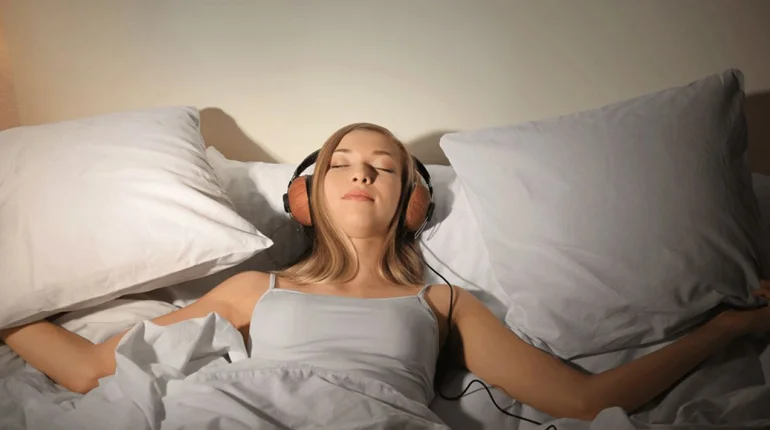Do Binaural Beats Actually Work For Sleep?

What Are Binaural Beats?
Binaural beats are an auditory illusion perceived when two slightly different sound frequencies are played separately into each ear. The brain interprets the difference between these frequencies as a single tone, the binaural beat. For example, if a 440 Hz tone is played in one ear and a 444 Hz tone in the other, the brain perceives a 4 Hz binaural beat.
These beats are often embedded in calming sounds like white noise, nature sounds, or soft music. They’re designed to influence brainwave activity, potentially inducing specific mental states associated with relaxation, focus, or sleep.
How Do Binaural Beats Actually Work?
The theory behind binaural beats is based on brainwave entrainment, a process that suggests the brain can synchronize its electrical activity with external stimuli, particularly rhythmic sounds or light pulses.
When exposed to binaural beats, the brain matches its electrical frequencies to the perceived beat frequency. This synchronization is thought to induce brain states associated with the target frequency:
- Delta waves (0.5-4 Hz): Deep sleep
- Theta waves (4-8 Hz): REM sleep, deep relaxation
- Alpha waves (8-13 Hz): Light relaxation, calm focus
- Beta waves (13-30 Hz): Active, alert thinking
- Gamma waves (30-50 Hz): High-level information processing
It’s important to note that while this theory is widely discussed, scientific evidence supporting its effectiveness is mixed.
Types of Binaural Beats
Different frequencies of binaural beats are associated with various mental states:
Delta Binaural Beats (0.5-4 Hz)
These are linked to deep, dreamless sleep and are often used in sleep-inducing audio tracks.
Theta Binaural Beats (4-8 Hz)
Associated with REM sleep, deep relaxation, and meditation, these beats are commonly used for stress reduction and improved creativity.
Alpha Binaural Beats (8-13 Hz)
Alpha Binaural Beats (8-13 Hz) is your ticket to a state of light relaxation. They are often used to promote calmness and reduce anxiety, leaving you feeling soothed and relaxed.
Beta Binaural Beats (13-30 Hz)
Beta Binaural Beats (13-30 Hz) is your go-to for active and alert thinking. They are sometimes used to improve concentration and problem-solving abilities, empowering you to stay focused and on top of your game.
Gamma Binaural Beats (30-50 Hz)
Gamma Binaural Beats (30-50 Hz) is your key to high-level cognitive functioning. While less commonly used for sleep purposes, they can stimulate your intellect and keep your mind sharp.
Can Binaural Beats Really Help You to Sleep Better?
The effectiveness of binaural beats for sleep improvement is a topic of ongoing research and debate. While some studies suggest potential benefits, others find limited or no significant effects.
A 2018 study published in Frontiers in Human Neuroscience found that binaural beats in the theta (6 Hz) range were associated with increased frontal midline theta power, a marker of drowsiness. It suggests a potential role in facilitating sleep onset.
However, a 2017 review in Psychological Medicine concluded that while some studies show promise, the overall evidence for the effectiveness of binaural beats in improving sleep quality is limited and inconsistent.
It’s worth noting that individual responses to binaural beats can vary significantly. Some people report improved sleep quality and easier sleep onset, while others experience no noticeable effects.
How To Use Binaural Beats Correctly?
If you’re interested in trying binaural beats for sleep, consider these guidelines:
- Choose the right frequency: Delta (0.5-4 Hz) or theta (4-8 Hz) beats are typically recommended for sleep.
- Use stereo headphones: Binaural beats require each ear to receive a different tone, so headphones are essential.
- Set a comfortable volume: The audio should be audible but not loud enough to disturb your sleep.
- Create a sleep-friendly environment: Ensure your bedroom is dark, quiet, and comfortable.
- Start with short sessions: Begin with 15-30 minute sessions before gradually increasing the duration if desired.
- Be consistent: Regular use may be more effective than sporadic sessions.
- Combine with good sleep hygiene: Binaural beats should complement, not replace, healthy sleep habits.
What are the side effects and benefits of Binaural Beats?
Potential Benefits:
- Improved sleep quality
- Reduced anxiety and stress
- Enhanced relaxation
- Increased focus and concentration
- Potential pain reduction
Possible Side Effects:
- Headaches or dizziness in some individuals
- Potential interference with certain medical conditions (e.g., epilepsy)
- Temporary changes in mood or mental state
It’s important to note that while many users report positive experiences, the scientific evidence for these benefits is still limited and sometimes conflicting. As with any sleep aid or therapy, it’s advisable to consult with a healthcare professional before incorporating binaural beats into your sleep routine, especially if you have any pre-existing medical conditions.
Remember: While binaural beats may be helpful for some individuals, they are not a substitute for addressing underlying sleep issues or maintaining good sleep hygiene practices.
Thanks for reading and stay updated with Neurobeats.

Ekua is an online content editor for ModafinilHack currently. Before joining our team, she was a senior editor for The Walt Disney Company. Earning expertise and editorial experience, she is now contributing her health, nootropics, and psychology knowledge. She’s a graduate of UCLA, where she majored in English.



